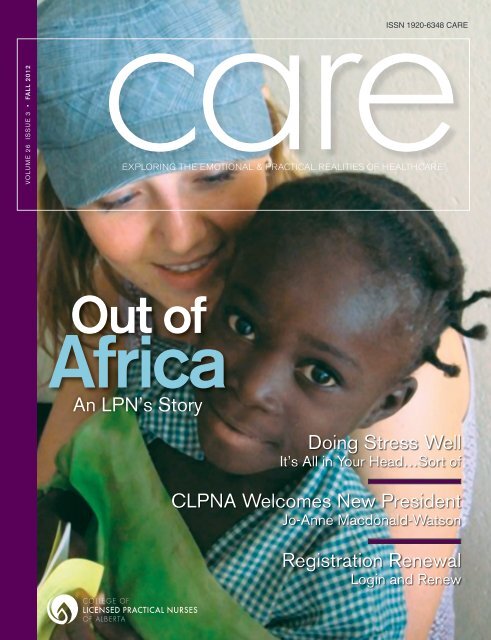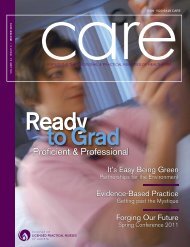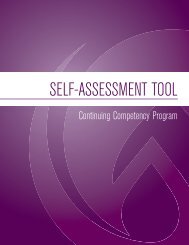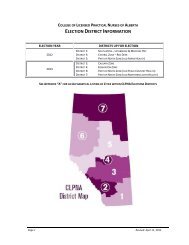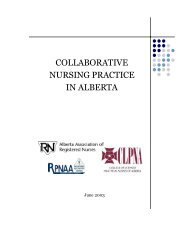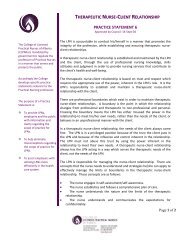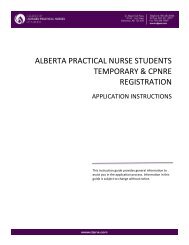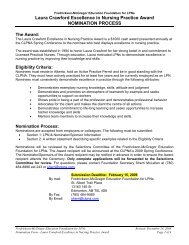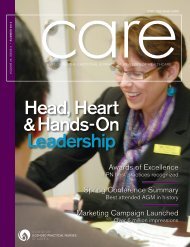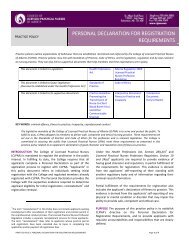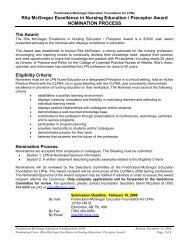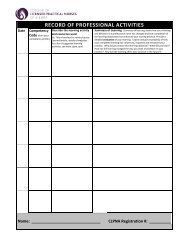Download PDF - College of Licensed Practical Nurses of Alberta
Download PDF - College of Licensed Practical Nurses of Alberta
Download PDF - College of Licensed Practical Nurses of Alberta
- No tags were found...
You also want an ePaper? Increase the reach of your titles
YUMPU automatically turns print PDFs into web optimized ePapers that Google loves.
2013 CLPNA SPRING CONFERENCEApril 17-19, 2013 Banff, <strong>Alberta</strong>This conference will uniquely examinethe whole patient ~ Body, Mind, Spirit ~through the mental, physical, spiritual,emotional, and psychosocial elementsaffecting a person. Opportunities fornetworking and collaboration will refreshand rejuvinate nurses and colleagues.SAVE THE DATE!Come enjoy the fresh spring mountain airin Banff, <strong>Alberta</strong> - exploring deepercomponents <strong>of</strong> health care best practices.Watch for coming details atwww.clpnaconference.com2 care | volume 26 issue 3
insidefall 2012VOLUME 26 ISSUE 38cover storyOne LPNs StoryShowcasing a young woman’sdesire to be a nurse, providecare to others, and shine withcompassion in most difficultcircumstances, this story isinspiring.Cover Photo:LPN Tina Wiebe and Solange, hersponsored child, in Boura, Burkina Faso,Africa - courtesy <strong>of</strong> Bridges <strong>of</strong> Hope.214 From the <strong>College</strong>212331My ‘Non-Negotiable 3’Living an Energetic LifeMental Health Rights in <strong>Alberta</strong>Mental Health Patient AdvocatesThe Operations RoomStay Informed with Member Information17featureDoing Stress Well - Part IThe impact <strong>of</strong> stress on thehuman body is well studied.This feature examines stressthrough humorous storiesand practical examples, withpractical approaches to helpthe reader.CARE is published quarterly and is the <strong>of</strong>ficial publication <strong>of</strong>the <strong>College</strong> <strong>of</strong> <strong>Licensed</strong> <strong>Practical</strong> <strong>Nurses</strong> <strong>of</strong> <strong>Alberta</strong>. Reprint/copy <strong>of</strong> any article requires prior consent <strong>of</strong> the Editor <strong>of</strong>Care magazine. Editor - T. BatemanSigned articles represent the views <strong>of</strong> the author and notnecessarily those <strong>of</strong> the CLPNA.The editor has final discretion regarding the acceptance <strong>of</strong>notices, courses or articles and the right to edit any material.Publication does not constitute CLPNA endorsement <strong>of</strong>, orassumption <strong>of</strong> liability for, any claims made in advertisements.Subscription: Complimentary for CLPNA members, $21.00for non-members.8care | fall 2012 3
Build on your Nursing Skills atBow Valley <strong>College</strong>…and save*Bow Valley <strong>College</strong> Alumni working as LPNs are eligible for a 10% discount on select* ContinuingEducation courses that qualify as continuing competency activities upon annual licence renewal.• Leadership for <strong>Licensed</strong> <strong>Practical</strong> <strong>Nurses</strong> - Online• Care <strong>of</strong> an Agitated Client *• Documentation Refresher *• Infusion Therapy – Fluid, Blood and Medication *• Intramuscular and Intradermal Injections *• Intravenous Medication Administration *• Immunization – Online or Homestudy *• Basic Foot Care *For more information about our medical courses please call 403-410-1499 or email lpn@bowvalleycollege.caYour Bow Valley <strong>College</strong> tuition may be eligible for a grant from the Fredrickson-McGregor EducationFoundation for LPNs. For more information visit: foundation.clpna.com6 care | volume 26 issue 3
farewellReflectionAs I finish my tenure as the President <strong>of</strong> CLPNA, I reflect on involvement with thepr<strong>of</strong>ession and my career as an LPN. I have been asked many times “Who areLPN’s and what do they do?” This is always an interesting question, as there areso many directions one can go with an answer. LPNs are bedside nurses, public healthnurses, operating room nurses, dialysis nurses, foot care and orthopedic nurses, but weare more than that. We work in corrections, home care, long term care, and we managefacilities, wings <strong>of</strong> facilities, and lead dementia units. Everywhere I go, I discover LPN’sadvancing in new areas as our pr<strong>of</strong>ession continues to advance and opportunities grow.As I started my work as a Council member with the <strong>College</strong> <strong>of</strong> <strong>Licensed</strong> <strong>Practical</strong><strong>Nurses</strong> <strong>of</strong> <strong>Alberta</strong> several years ago, I learned a great deal about the CLPNA. As a selfregulatingnot-for-pr<strong>of</strong>it organization, CLPNA regulates and leads the LPN pr<strong>of</strong>ession.Often I am asked what that means to you, practicing LPNs.A pr<strong>of</strong>ession cannot exist without the formation <strong>of</strong> some very core elements. Standardsin education, registration, conduct, and practice are necessary. Scope <strong>of</strong> practice mustbe defined through competency development and advocacy. Growth and change in thepr<strong>of</strong>ession must be managed based on many variables that affect the practice <strong>of</strong> thepr<strong>of</strong>ession. Additional competence and skills are brought forward for considerationand discussion among the pr<strong>of</strong>ession, employers, and stakeholders. Legislation andregulation is monitored to enable the full practice <strong>of</strong> the pr<strong>of</strong>ession. Communicationand collaboration is evident at every stop along the way, involving input from a host<strong>of</strong> contributors. The <strong>College</strong> is at the centre <strong>of</strong> all <strong>of</strong> this, working on our behalf forchanges that have resulted in the growth in our numbers to ten thousand members,with one <strong>of</strong> the most advanced and utilized scopes <strong>of</strong> practice for the pr<strong>of</strong>ession.Today, LPNs add value wherever health care is being delivered. As pr<strong>of</strong>essional nursesour roles and pr<strong>of</strong>essional competence are constantly adjusted to meet the requiredlevel <strong>of</strong> care needed in any given situation. For this we must take pride, as each providerwho works to the maximum <strong>of</strong> their education and scope <strong>of</strong> practice brings the bar upa notch. In a perfect world this would apply to every pr<strong>of</strong>essional. However, we’re notthere yet; there is still work to do to achieve full utilization, opportunity, and respectfor all providers. It takes all <strong>of</strong> us, no single group or individual has credit for the highquality <strong>of</strong> care we provide. We must never assume that things will stay the same inhealth care.I am so proud to be an LPN. During my time at CLPNA, I have been privileged to workwith and witness compassionate and competent people from government all the waythrough to those who deliver bedside care. CLPNA Executive Director, Linda Stangerand her staff work tirelessly on our behalf, fulfilling the mandate <strong>of</strong> the <strong>College</strong>.It has been the most rewarding experience to represent our pr<strong>of</strong>ession on the Counciland as President. I am confident our momentum will continue. I send a gracious welcometo Jo-Anne Macdonald-Watson as our new President, and have every confidence in herskills to lead. She is a forward thinker with heart and passion for our pr<strong>of</strong>ession.Thank you for the opportunity to serve on Council and as your President.care | fall 2012 7
Out OfAFRICAAn LPN’s StoryBy CHRIS FIELDS8 care | volume 26 issue 3
“It’s the contradiction andcomplexity <strong>of</strong> Rwanda itself. It’slight and dark: the darkness in theolder eyes that saw the Genocide,a child leaning into the lightwith hope for the future.”Tina Wiebe, LPN>care | FALL 2012 9
Tina: “I remember the day I metGrace, my sponsor child in DRCongo. After meeting her at theschool, I gave her a gift fromCanada: school supplies, a newdress, a pair <strong>of</strong> sunglasses, anda doll. We went to her house.Her family welcomed me withopen arms and proudly tookme into their home - a littleshack with no windows anddirt floors. There was hardlyroom for all <strong>of</strong> us, as Grace’sfamily <strong>of</strong> seven and myself triedto arrange ourselves in whatwould have been the ‘livingroom.’ Grace left and returnedwith a beautifully wrappedshoe box and a bouquet <strong>of</strong>hand-picked flowers. As Iunwrapped this gift, I started tocry, overwhelmed with emotionrealizing what an honour itwas. Inside the box were foureggs, likely their provisions forthe week. To make my gift, shehad given me all that she had.It made my gift seem so smallin comparison. I had neverexperienced anything like thatbefore. I don’t think we (wholive in different circumstances)will ever know what it’s like toreally give.”Africa is a long way fromTina’s Mennonite upbringingin the small rural community<strong>of</strong> Vauxhall. “I grew upsewing dresses,” Tina says, describingthe Low German Speaking Mennonitecommunity as hard-working, agricultural,and sheltered from broader society.There was limited TV or radio, andoutside influence was kept to a minimum.“The norm is to marry youngand raise a family,” Tina explains, notingshe was the oldest <strong>of</strong> 5 kids (a typicalMennonite family has an average <strong>of</strong>7-10 children), and she has more than100 first cousins.Tina’s gateway to the world was readingbooks, particularly books aboutdoctors that travelled the world. “Ialways had dreams about helpingpeople,” Tina says. “I wanted to learnand to experience. Eventually, people Iknew didn’t want to do the same thingsin life as I did.”For Tina, the yearning to stretch wingsdidn’t translate to an easy path. Tinanotes culture must be understood andrespected in its context; for many inthe traditional Mennonite community,completion <strong>of</strong> high school isn’t a drivinggoal.When the Horizon School Divisionstarted a Mennonite high school program,Tina leapt at the opportunity.The local newspaper contacted her asa first grad <strong>of</strong> the program and ran astory. A business owner in Lethbridgeread the article and contacted Tina,wanting to help her realize her aspirations.The opportunity presented a fundamentallife choice: pursue a typicalcourse <strong>of</strong> life for a Mennonite girl, orpursue Frost’s “road less travelled” –the stuff <strong>of</strong> dreams.Stepping into the dream was a stepinto the unknown. Tina’s decision tobecome a nurse caused a rift in thefamily. She didn’t have a resulting supportnetwork, or two nickels to rubtogether. Hired by the Lethbridge businessowner as a hair salon assistant,Tina made money to be able to pay forhigh school upgrading needed to enrolin the LPN program at Lethbridge <strong>College</strong>.Aided by a grant, Tina graduatedfrom Lethbridge <strong>College</strong> in 2007.10 care | volume 26 issue 3
“With all its challenges and frustrations Africa is a place <strong>of</strong> true relationship and raw humanity.It’s a place <strong>of</strong> gratitude for what they have. Despite the little they have, the extreme poverty,and the injustices they endure, the heartbeat <strong>of</strong> Africa remains a joyous song and dance.I pray that one day they will be heard.”“Becoming an LPN was a dream cometrue,” Tina says. “I loved every minute<strong>of</strong> my education. I love the bedsidefocus <strong>of</strong> the LPN role.”Tina started working at LethbridgeRegional Hospital in day surgery, butshe was already dreaming about internationalwork. Initially discouraged byfour year degree and two year experiencerequirements <strong>of</strong> international aidorganizations, Tina came across an organizationin her backyard – Bridges <strong>of</strong>Hope (www.bridges<strong>of</strong>hope.ca) – thatmore broadly accommodated a person’spassion on a volunteer basis. Shebegan a new life journey by doing lots<strong>of</strong> fundraising, raising $10,000 andventuring to Africa and Burkina Faso– the third most impoverished nationon Earth - for the first time in October,2007.“I was heading there for three monthsto work at a Bridges <strong>of</strong> Hope clinic andhad no idea who would pick me upfrom the airport,” Tina says. It was aplace she immediately knew she wantedto be. “You see the World Visioncommercials and it doesn’t prepareyou. But the world suddenly opened.It was something I desired for so longand I connected right away.”Our preparation for life’s paths cancome from seemingly unlikely sources.For Tina, her “simpler” Mennonite upbringingprepared her for Africa’s challenges.“Being Mennonite taught me tobe flexible, adaptable, and to be comfortablewith less material comfort.”The care environment in Africa is welloutside any familiar structural system,and might best be described as a bootcamp for those wanting to learn advancedskills in a hurry. “A nurse inBurkina Faso would be a doctor here,”Tina says. “<strong>Nurses</strong> are in charge; theyare expected to do everything in BurkinaFaso including anaesthesiology andsurgery assistant (doctors are in shortsupply). In Africa, the family is expectedto provide personal bedside care.”A typical day in Africa for Tina is jack<strong>of</strong> all trades nursing: assist with babydeliveries and hernia repair surgeries,perform injections and wound care,take blood for HIV tests, assist withsymptom-based diagnosis (there’s nowaiting for lab results – there are nolabs), prescribe medications, organizeregional malnutrition sessions,conduct polio vaccination programs,and undertake education and teaching– particularly around malnutrition.“You learn quickly about how to judgeconditions,” Tina says. “You do thebest with what you have.” Tina addsthat her LPN education and hands-oncare orientation has been instrumentalin generating the adaptability requiredin Africa.Whether we discover our passions byaccident or on purpose, we can measurethe depth <strong>of</strong> passion by how muchwe feel changed by our experiences.“When I came back to Canada, I feltdifferent… that I didn’t belong,” Tinasays. So Tina got back on a plane backto Burkina Faso with fellow Lethbridge<strong>College</strong> LPN grads Sara, Angela, andAdrian in February, 2008 and spent amonth working in medical clinics. “Ihad learned from the first experience,could contribute more, and could sharemy learning with others.”Those first experiences in Burkina Fasobecame a springboard to bigger, bolder,and deeper experiences.In 2009, Tina organized and led herfirst medical team on a one month trip>care | fall 2012 11
to Burkina Faso. In 2010, Tina ledanother team and had a new title atBridges <strong>of</strong> Hope: International HealthPrograms Coordinator. Teams organizedand led by Tina now go backto Burkina Faso every year; the 2012team <strong>of</strong> 20 was the largest yet. Theteams mostly consist <strong>of</strong> RNs and LPNsbut have also included social workers,doctors, nursing students, and physiotherapists.crumbling down on them.” Organizingand operating in mobile clinics with10 nurses and two doctors, Tina saysif anything Haiti was more medicallychallenging than Africa because <strong>of</strong> thesoup mix <strong>of</strong> infectious diseases, HIV,malnutrition, and the usual more westernchronic conditions.The broadening <strong>of</strong> experience left Tinaasking a fundamental question: How“I do what I do because I see their faces. Part <strong>of</strong> me lives in Burkina Faso. It’s part <strong>of</strong> who I am. It’s part <strong>of</strong> my soul.”Tina made a fundraising link withHealth Partners International <strong>of</strong>Canada to fund medical supplies includingantibiotics, deworming medicine,antimalarials, and Tylenol. Oneach trip medical personnel now bringan extra suitcase with 50 pounds <strong>of</strong>medicine – a bag worth $5000 thatcosts a mere $500.Tina pursued more education to advanceher skills, with a two week stintin Kansas City to take an internationalmedicine diploma course in 2009, followedby six months at the London(England) School <strong>of</strong> Hygiene and TropicalMedicine to complete a TropicalNursing Diploma in 2011 (financiallysupported by a community donor inLethbridge).Tina also visited other countries inAfrica, and Haiti, as Tina describes it“to see a bigger picture <strong>of</strong> need.”In 2010, Tina visited Rwanda to workin two clinics. Tina describes Rwandaas a country that is beautiful, and hascome a long way since its civil war inthe 1990s. “I lived in the jungle withbushmen. There were bed bugs, micechewed through my bags, there was noelectricity.” From there, Tina traveledto DR Congo. “The bushmen couldn’tdrive, so I had to drive to the border.”Tina describes being pulled over by amachine gun wielding policeman. Petrified,thinking she would go to jail,she showed him her <strong>Alberta</strong>’s driver’slicense. The cop waived her on. Tinacompares DR Congo to Rwanda asbeing like night and day. “The birdswere chirping on the Rwandan side <strong>of</strong>the border. When I got to the borderthere were no birds. It was like seeinghell. The roads were torn up anddusty. Everything was grey. There wereUN tanks on every corner. It was likea movie.” As Tina describes it, sheworked for two weeks on mostly prenataland HIV cases in a refugee camp“in conditions I wouldn’t put animalsin.” “I had a woman walk up to mewith no children… no possessions.She said her whole family was killedin front <strong>of</strong> her eyes. Those things staywith you.”Tina also led a medical team to Haitisix months after the earthquake. “Isaw a natural disaster in slow motion:camps, thousands displaced, palpablefear, people worried about their housescan I do more?For Tina, the answer lies in a transitioning<strong>of</strong> her own role to an emphasison education, which Tina says is amore enduring solution than treatmentover the long term. Nutrition education(e.g. increase protein and utilize12 care | volume 26 issue 3
other local foods like millet), and hygieneeducation are pillars. “People arereally appreciative <strong>of</strong> learning,” Tinasays, as she notes that dissemination<strong>of</strong> knowledge is good but you haveto learn from specific cultural contextand seek two way dialogue. Or in thewords <strong>of</strong> Bridges <strong>of</strong> Hope founderDaniel Zopoula, “seek to understandrather than be understood.” This deeplyheld belief is reflected in the handout-hand up duality <strong>of</strong> the Bridges <strong>of</strong>Hope mission statement: to promotepoverty relief and community empowermentamong the poorest nations <strong>of</strong>the Earth.Life can be fickle in Africa. Typical cases– asthma, infectious disease, pneumonia(leading cause <strong>of</strong> death in childrenworldwide), malaria, pre-natalissues, schistosomiasis, malnutrition– are things that are so preventable orare unheard <strong>of</strong> in <strong>Alberta</strong>. “It’s hard tosee the tell-tale bloated tummies, orangehair and skinny arms <strong>of</strong> the kidsthat indicate malnutrition,” Tina says.“Malaria is taking generations away.AIDS lurks around every corner.”Tina recalls her most challenging day,when a Mom came in with a threemonth old baby in seizure. There wereno other nurses around and the mom,wanting help, approached Tina. “I felthelpless,” Tina says. “I had to wait untilthe baby came back to a consciousstate, which is the worst feeling. I eventuallyfound some local nurses whospoke tribal languages I don’t speak,but I was expected to have answers.The local nurses didn’t know what todo. We did an IV then a spinal tap. Thebaby screamed in a way I don’t want toremember.” Tina says the diagnosis waslate stage meningitis. “The nurses toldthe mother to go to the hospital, butthe family had walked all day to get tothe clinic. And so the mother was sentinto the dark <strong>of</strong> night with her deathlyill baby to walk miles to the hospital.”Weeks later, the Mom recognized Tinaat the hospital and urged her to comesee her baby, alive and recovering.Asked whether Africa can seem overwhelming,Tina responds that “it’s notan excuse for doing nothing.” Thatdeath is so visceral, that life is less ournotion <strong>of</strong> endurance sport and more <strong>of</strong>a fleeting gesture, is perhaps the veryreason why Tina says Africa gets intoyour soul. For all <strong>of</strong> life’s raw travail,life is joyful. “People value life differently,”Tina says. “Relationships withpeople mean more than anything culturally.People will be late for meetingsbecause they’re always stopping on theroad to talk.” And where life ends itbegins anew. The family Tina stayedwith in DR Congo for two weeks hada baby two months ago. They namedthe baby Tina.Bridges <strong>of</strong> Hope is about more thanmedical clinics. It’s holistic, focusingon sustainable initiatives ranging fromwater projects to child sponsorship. Theorganization also runs an orphanage.Where babies used to die from failureto thrive, spending their days lying ona cement floor, the new orphanage hasimproved services, with more staff,better nutrition and hydration, andlove and attention. The orphanage is>“There are days I’m sadthat our ‘bubbled’ livesturn a back on so much<strong>of</strong> the world that is dying<strong>of</strong> hunger and preventabledisease. Every day tinybabies in the orphanage inBurkina Faso lie in theirlittle cribs waiting...forsomeone to touch them, tospeak loving words in theirears, to sing to them...tohave a family. The womenworking here <strong>of</strong>ten can’tkeep up with the workthat’s needed for thesechildren. They do the bestthat they can with whatthey have. When I comeback to Canada, I will hear<strong>of</strong> another orphan that haspassed away. I know thattouch is vital for survival,especially in the first years<strong>of</strong> life. To think that many<strong>of</strong> these children live and diewithout it…crushes me.”care | fall 2012 13
JOB OPPORTUNITIES<strong>Licensed</strong> <strong>Practical</strong> <strong>Nurses</strong><strong>Alberta</strong> Health Services (AHS) is one <strong>of</strong> the leading healthcare systems in Canada, responsible forthe delivery <strong>of</strong> healthcare to more than 3.7 million <strong>Alberta</strong>ns. We operate more than 400 facilities,including 84 acute care hospitals and emergency centres, cancer treatment centres, communityhealth centres, and addiction & mental health facilities. AHS values the diversity <strong>of</strong> the people andcommunities we serve and is committed to attracting, engaging and developing a diverse andinclusive workforce.There will be new exciting career opportunities upcoming for <strong>Licensed</strong> <strong>Practical</strong> <strong>Nurses</strong> atthe new North Edmonton Remand Centre. With a strong commitment to work/life balance,competitive benefits and a collaborative work environment we know we have a career that will fityou. Working at AHS enables a better quality <strong>of</strong> life, not only for our staff, but for their families –there’s no shortage <strong>of</strong> reasons to join our team.www.albertahealthservices.ca/careersFor more information email careers@albertahealthservices.ca or search and apply for jobs on our websiteReveal anew youAdvance your career with theIntegrative Health Coach ExtensionCertificate from Mount Royal UniversityContinuing Education.Information:403.440.6867or toll-free 1.866.616.3606or cehealth@mtroyal.caRegistration:403.440.3833or toll-free 1.877.287.8001mtroyal.ca/contedcare | fall 2012 15
16 care | volume 26 issue 3
It’s Allin YourHead...Sort OfBy Ron Culberson, MSW, CSPPart I – Doing Stress WellThis is the first <strong>of</strong> two articles on stress management. In thisarticle, Ron discusses the stress process. In the second article,he describes how to use humor to manage this process.After five weeks <strong>of</strong> needles, bedpans, and green hospitalJello (not in that order) and six weeks in a leg-hip-legcast, I had finally graduated to crutches. The final step<strong>of</strong> my recovery from a compound fracture <strong>of</strong> my femur wasphysical therapy. For a ten year-old, it had been a long, hardroad and I wanted to get back to kicking my sisters.The physical therapist, Dr. Ed Hill, resembled a bouncer onsteroids. He wore a tight t-shirt with rolled up sleeves, hada large tattoo <strong>of</strong> the Navy insignia on his bicep, and alwaysgnawed on the stub <strong>of</strong> a cigar. It was 1971, before smokingand cruelty were prohibited in hospitals. Dr. Hill instructedme to lie on the exam table and then politely asked me tobend my leg as much as I could. After being immobile for11 weeks, my leg had forgotten how to bend. I gruntedand groaned and achieved approximately one degree <strong>of</strong>movement.“You can do better than that,” he said.“No. That’s about it.” I said, smiling.Before I knew it, he punched me in the stomach andinstinctively, I drew both knees to my chest. My leg screamedin pain. I screamed in fear.“Good,” he said, “I knew you could do it.”On subsequent visits to see Dr. Hill, about a mile fromthe hospital, I would notice a pronounced tremor in myhands and sweat on my upper lip. Luckily, today, at age48, the nightmares have almost completely disappeared.But physical therapists still scare me more than just aboutanything... except clowns.Clearly Dr. Hill’s behavior was unpr<strong>of</strong>essional and potentiallycriminal, but this story demonstrates how his stress becamemy stress. Although this is dramatic example, does it soundfamiliar? Have you seen it in yourself, your family, or yourcoworkers? That’s because it’s normal to experience stressand while you can’t change what happens to you, you havecomplete control over what you do in response to stress.Humor can help - as long as you understand the context <strong>of</strong>stress itself.The Process <strong>of</strong> StressAs a social worker, I am well versed in a variety <strong>of</strong> stressmanagement techniques. From relaxation to meditation tohypnosis, drugs and heavy drinking, I’ve tried it all. Thechallenge, however, is that most healthy stress managementtechniques require laser clear focus and regular practice. Tobe honest, I have never been good at the whole focus thingbecause I am too easily distracted. For instance, if I need to>care | fall 2012 17
elax and try to visualize my “happy place” by imagininga sunny beach or a mountain cabin, my mind quicklybegins to wander and before I know it, I’m watching ashark attack or a scene from Deliverance in my new veryunhappy place.Humor, on the other hand, is a great way tomanage stress and for me, it’s a much easiertechnique to use on a consistent basis.Even though it to requires focus andregular practice, it’s a more funand makes the whole processmore enjoyable. But beforewe get into the specifichumor techniques, it isimportant to understandthis beast known as“stress” first.Did you know thatstress is not inherentlyinherent? In otherwords, the stressor (thatthing that causes thestress) is not in and <strong>of</strong> itselfstressful. I know, it soundscrazy but work with me onthis one. You see, our cognitiveinterpretation <strong>of</strong> the stressor andthen our subsequent reaction to itare what cause the stress we experience– not the stressor itself. Maybe a visual willhelp. Here is the formula for I’m describing:IMPACT OF STRESS = Stressor + Our Interpretation +Our Reaction + How We CopeSo we experience stress when the formula plays out likethis:STRESS = Stressor + Negative Interpretation + NegativeReaction + Bad Coping Skills2. Someone asks why your hair is green and you know fullwell that your hair is not green; you assume the personis mentally imbalanced and disregard his/her commentimmediately. Once it’s disregarded, it’s gone from yourmind, you have no reaction whatsoever and experience nostress.In the first example, the interpretation <strong>of</strong> whatthe comment means or represents leads todeeper issues on which you then focus.That leads to stress. If, instead,you did not “read” too muchinto the comment, you wouldexperience less stress. In thesecond example, you haveno emotional connectionto the comment and thusno stress reaction. Theinterpretation is critical tothe stress we experience…or don’t.I am not suggesting that youdisconnect completely fromany stressor. However, themore you focus on the negativeaspects <strong>of</strong> any situation, themore you will experience stress.Also, it’s important to understandthat some major life stresses areinherently stressful. The death <strong>of</strong> a lovedone, a serious illness, or when your mothermade you wear that ridiculous flower outfit for theschool assembly when you were in 7th grade and werealready concerned about what people thought <strong>of</strong> you areprobably going to cause stress. That last example is just ahypothetical one.Once we recognize that there are several steps along thestress pathway that can be stopped, then we can look forways to use humor as the brakes. In Part II <strong>of</strong> this topic,we’ll take a look into the interventions more specifically. nTo illustrate this further, here are two examples:1. Suppose your spouse suggests that you could lose a fewpounds. Immediately, the insecurities <strong>of</strong> your body imagerise to the surface and you hear your mother’s voice fromyour childhood saying, “You need to go on a diet” or“Why are you so lazy?” or “You’re wearing that?” Youreact with anger, but since anger is not a pleasant norsocially acceptable emotion, you turn the anger inwardsand become depressed. And whenever you’re depressedwhat do you do? You eat – which causes guilt, stress andmore eating. If on the other hand…© 2012 Ron Culberson, MSW, CSP is a former hospicesocial worker, middle manager, and senior managerwho helps mission driven organizations tap into thepower <strong>of</strong> combining excellence with humor. Ron is theauthor <strong>of</strong> Do it Well. Make it Fun., Is Your Glass LaughFull?, and My Kneecap Seems Too Loose. Find outmore by visiting www.RonCulberson.com.18 care | volume 26 issue 3
FALL AND WINTER WORKSHOPS COMING TO ALBERTAHelping Communities and Organizationswith Issues <strong>of</strong> Crisis and TraumaTO REGISTER OR FORMORE INFORMATION:www.ctrinstitute.com204.452.9199info@ctrinstitute.comANXIETY - <strong>Practical</strong> Intervention StrategiesEdmonton: October 18, 2012; Calgary: October 24, 2012DEPRESSION - <strong>Practical</strong> Intervention StrategiesEdmonton: October 19, 2012; Calgary: October 25, 2012DE-ESCALATING POTENTIALLY VIOLENT SITUATIONSFort McMurray: November 27, 2012; Edmonton: November 28, 2012; January 29, 2013Calgary: November 29, 2012RESTORATIVE JUSTICE- Guiding Principles for Communities and OrganizationsEdmonton: November 29, 2012; Calgary: November 30, 2012MOTIVATING CHANGE- Strategies for Approaching ResistanceCalgary: December 5-6, 2012; Edmonton: December 13-14, 2012UNDERSTANDING MENTAL ILLNESSCalgary: December 11, 2012; Edmonton: December 12, 2012; Grande Prairie: December 13, 2012TRAIN-THE-TRAINER- De-escalating Potentially Violent SituationsEdmonton: January 29-31, 2013ADDICTIONS AND MENTAL ILLNESS- Working with Co-occurring DisordersEdmonton: February 20, 2013; Calgary: February 21, 2013SUBSTANCE ABUSE AND YOUTH- Creating Opportunities for ChangeEdmonton: February 21, 2013; Calgary: February 22, 2013www.ctrinstitute.comWEBINARSNo matter where you live, youcan easily access some <strong>of</strong> CTRI’sworkshops right from your desk.Our 70-90 minute webinars <strong>of</strong>feryou the opportunity to hear, viewand engage with our trainers.Contact CTRI for details.Facilitating Learning That PromotesCollaboration And Maximizes ProductivityWORKSHOPS COMING TO ALBERTA THIS FALL AND WINTERDEALING WITH DIFFICULT PEOPLECalgary: October 22, 2012Edmonton: October 25, 2012ASSERTIVE COMMUNICATIONCalgary: October 23, 2012Edmonton: October 26, 2012FOUNDATIONS FOR OUTSTANDINGWORKPLACE PERFORMANCECalgary: November 20, 2012Edmonton: November 22, 2012MEDIATION- An Informal Process for Conflict ResolutionEdmonton: December 17-18, 2012EMOTIONAL INTELLIGENCE- Value in the WorkplaceEdmonton: February 26, 2013Calgary: February 28, 2013CONFLICT RESOLUTION SKILLSEdmonton: February 27, 2013Calgary: March 1, 2013MANAGING PERSONALITIES- Myers Briggs for LeadersCalgary: November 21, 2012Edmonton: November 23, 2012LEADERSHIP AND MANAGEMENT- The Essential FoundationsEdmonton: December 11, 2012Calgary: December 13, 2012TO REGISTER OR FOR MORE INFORMATION:www.achievecentre.com 204.452.0180 info@achievecentre.comcare | fall 2012 19
JOIN AWINNING TEAMhelp shapehome care practicesour Calgary, Red Deer and Edmonton locationsare currently recruitingCommunity Care Supervisors - LPNFor more information or to apply please e-mail:hrhomehealth@cbi.ca or visit our website cbi.ca/homehealthAdvanced Education inOrthopaedics Certificatefor LPNsNorQuest’s Advanced Education in Orthopaedics certificatewill open doors for you and provide many opportunities.Learn about advanced orthopedic assessment, traumaand specialized procedures including casting.For more information, call 780-644-6366or email laura.milligan@norquest.caTo register, call 780-644-6000or toll-free 1-866-534-7218www.norquest.ca20 care | volume 26 issue 3
My ‘Non-Negotiable 3’Health Practices For Living An Energetic LifeBy Michelle Cederberg, Certified Speaking Pr<strong>of</strong>essional, MKin, BA Psyc, CEP, Co-Active CoachDo you overwhelm yourself withthe idea that good health is toocomplicated and takes too muchtime? Yes, we have a lot <strong>of</strong> choicesthrown at us every day to improvehealth and longevity but don’t overthink it. When life gets busy and theschedule doesn’t seem to have room formore than small steps, take them. Mythree ‘non-negotiable’ health practices- the one’s I will ensure get daily focus- are essentially things you need to bedoing every day anyways, so why notsimply make the decision to do each <strong>of</strong>them a little better?The first is exercise. I know we don’thave to do this one every day but sinceit’s the key way your body will stayhealthy and capable <strong>of</strong> energizing youthrough the day why on earth wouldyou skip it? Well, I know the answerto that… we skip it because we don’thave the time, energy or motivationto fit in fitness. But your energy andmotivation won’t change unless youfind the time, so start with small steps.Your fitness goal is to consistently domore than what is normal for you, soif you’re currently not exercising thenas a starting point, a daily 10 minutewalk will make the world <strong>of</strong> differenceto your health. If you follow the ruleto consistently do more than whatis normal for you, then 10 minutes<strong>of</strong> movement will become 12, then15 minutes, or maybe you’ll walk uphills or add in stairs. You get the idea.MOVE.The second is to eat a bit better everyday. I love food so I’ll be the last personto tell you to stop eating (or drinking)everything you love, but I will tell youthat moderation and education will goa long way to increasing your energyand decreasing your waistline. Everyday choose to less sugar, fat and flour- processed foods have a lot <strong>of</strong> these.Choose more fruits, vegetables andhealthy, fresh foods instead. Decreaseyour portion sizes just a bit. Skip thevending machine as a food source(there’s nothing healthy in there). Packhealthy snacks for the day. Drink waterinstead <strong>of</strong> soda or fruit juices. If you eathealthier throughout the day you makeroom for enjoyment <strong>of</strong> some <strong>of</strong> yourfavorite foods minus the guilt. Learn abit about the foods you’re feeding yourbody. Educate yourself on the demeritsthat processed foods give you and themany merits <strong>of</strong> fresh and lean. That’senergizing.The last <strong>of</strong> my ‘non-negotiable 3’ is toget better sleep. Prioritize it. It’s duringsleep that your body repairs itself fromthe stress <strong>of</strong> the day. Sleep makes youhealthier, stronger and more energizedyet it’s something that busy people ‘fitin’ when they have the time. Make thetime. If more hours aren’t possible thenmake sure the hours you’re getting arerestful. Develop a pre-sleep routine thatwill help you doze <strong>of</strong>f more quickly.Fatty or high-protein foods before bedmay keep you awake as your bodyworks harder to digest them. Too muchTV, internet or video games will keepyour brain stimulated longer so cutthose out before bed too. Read or takea bath. Stretch or meditate. Sip a cup<strong>of</strong> (non-caffeinated) tea. Wind down atleast 30 minutes earlier, or better yet,skip the s<strong>of</strong>a and TV altogether andchoose to go to bed earlier. Part 2 <strong>of</strong> thesleep experiment is to make sure you’veoptimized your sleep environment.You’ll sleep a lot better if your room iscool (18C or so), dark, and clean. Finda pillow that is comfy and suits yoursleep style, and if possible make sureyour bed provides you the right type <strong>of</strong>support.Move a bit more, eat a bit healthier,optimize your rest and recovery andyou’ll gain better Energy Now! nAbout Michelle:With over 20 years experience as aspeaker, author, educator, fitness pr<strong>of</strong>essional,life coach and entrepreneur,Health and Productivity Expert MichelleCederberg has developed innovativeand practical methods to solve our enduringhealth and energy dilemmas in arealistic and do-able way.These energy tips are excerpted fromher new book Energy Now! Small Stepsto an Energetic Life available on Amazonor at your favorite book store. Learnmore at www.worklifeenergy.comcare | fall 2012 21
Become aCERTIFIED PROFESSIONAL CANCER COACH40% OffOctober 1 – 31 stDistance EducationPromotion*2012Distance Education Program is an Online E-Learning program in Integrative Oncology – coveringNutritional, Lifestyle, Clinical & Integrative Applications in Oncology. Program cost includes tutor, postcertificationmentor, monthly webinars, student networking support, CPCC designation, qualification as a Level 3Registered Cancer Patient Educator with National Association <strong>of</strong> Pr<strong>of</strong>essional Cancer Coaches, and so much more.Email us: pcci@cogeco.ca for your free program information package by email.*40% discount to <strong>Alberta</strong>’s <strong>Practical</strong> <strong>Nurses</strong>’. Members only.www.cancerwipeout.com / www.pcciprogram.comPROUD EDUCATORS to theThe Ottawa Regional Cancer Foundation !www.napcc.ca Proud Supporters <strong>of</strong>Canada’s Certified Pr<strong>of</strong>essional Cancer Coaches. Since 2008Canada’s first and only independent CE Pr<strong>of</strong>essional OncologyProgram for <strong>Nurses</strong>, M.D.’s and other practitioners. Since 2004healing the healer!Overcome the 3 Biggest Challenges that Keep YouOverworked, Overwhelmed, and Drained by Day’s End!At the FREE Sound Wellness mini-Workshop, we will reveal...✔✔✔New ways you can care for yourself soyou can continue to care for others..Scientifically validated methodsproven to reduce your stress withMusic and Sound.The #1 BEST way to instantly Reset,Rebuild, Replenish and Re-align yourenergy!... plus much, much more ! ! !tickets are $20FREE when youpre-register nowCall 800.748.4082to leave youremail addressupcoming Workshops inCalgary and EdmontonWorkshops run 7–9:30 pmwww.soundwellness.com/healersHElping YOu CarE fOr YOursElf sO YOu Can COntinuE tO CarE fOr OtHErs.22 care | volume 26 issue 3
at issueMental HealthRights in <strong>Alberta</strong>By Connie BrysonEvery year, about 7,500 <strong>Alberta</strong>nswith mental disorders are involuntarilydetained at psychiatric facilitiesfor examination, assessment, andtreatment. The Mental Health Act <strong>of</strong><strong>Alberta</strong> provides the authority, protocols,and procedures for admitting andtreating these patients. The act alsosafeguards them against wrongful ormalicious detention and protects theirrights.Given the history <strong>of</strong> how people withmental illness have been treated andthe portrayal <strong>of</strong> psychiatric hospitalsin popular movies, it’s no surprise thatmany <strong>of</strong> us would rather “forget” thesefacilities exist. But they shouldn’t be amystery, says Fay Orr, <strong>Alberta</strong>’s MentalHealth Patient Advocate, because lack<strong>of</strong> knowledge <strong>of</strong> the mental health systemcan contribute to the stigma (negativeattitudes) around mental illness.“One in five Canadians will experiencea mental illness in their lifetime. Stigmaprevents many people from seekinghelp or delays them from seeking helpuntil their issue is critical. I think it’simportant for people to have an idea <strong>of</strong>how the system works, the process <strong>of</strong>committing someone to a hospital, andthe assurances they have that patientsare treated properly and respectfully.”<strong>Alberta</strong> is a leader in protecting therights <strong>of</strong> the most seriously mentallyill. The province established the MentalHealth Patient Advocate Office in1990; now, the <strong>Alberta</strong> <strong>of</strong>fice is still theonly provincial investigative body inCanada created specifically to deal withcomplaints from or related to peoplewho are involuntarily detained at mentalhealth facilities. The jurisdiction <strong>of</strong>the Advocate was recently broadenedto include people under a communitytreatment order, a tool to help individualscomply with their treatment whileliving in the community. The Advocate’sposition is appointed by cabinetand reports directly to the Minister <strong>of</strong>Health and Wellness.“By protecting the rights <strong>of</strong> the mostseriously mentally ill, we help createan atmosphere <strong>of</strong> understanding andhope for everyone on the journey <strong>of</strong> recoveryto mental well-being,” says Orr.“We help those struggling with mentalillness feel less alone by treating themwith dignity and respect – somethingmany <strong>of</strong> us take for granted.”Patients who are involuntarily detainedat psychiatric hospitals are amongthe most vulnerable in our healthcaresystem. Although some <strong>of</strong> their civilliberties are suspended during theirdetainment, they do retain importantrights. These rights include the rightto information, such as why they arein the hospital; the right to consentto treatment (if deemed competent tomake treatment decisions); the right toappeal to an independent review panel;and the right to a lawyer. Another keyright is that these patients – or thoseacting on their behalf – may contact theMental Health Patient Advocate if theyhave a concern with their rights, detention,treatment, or care.The Advocate’s <strong>of</strong>fice hears fromroughly 750 patients per year. Complaintsrange widely, including issuesaround legislated rights, hospital food,and allegations <strong>of</strong> physical assaults.All complaints are investigated. Mostinvestigations are informal and areresolved in a short time; a handful <strong>of</strong>cases result in formal investigationsand written reports. <strong>Alberta</strong> HealthServices is asked to respond to recommendationsmade in these reports. Recommendationshave included improvedtraining for staff, changes to policy andprocedures, and in rare cases, disciplinaryaction for staff.“Over the past 20 years, the Advocate’srecommendations have helped improvethe patient experience,” says Orr. “Ourtrack record demonstrates to patientsthat there is someone who will listen.They won’t be dismissed, and theircomplaint will be resolved fairly.”In recent years, the Advocate’s role hasbroadened beyond investigating complaintsand providing patients with informationabout their rights. The <strong>of</strong>ficeworks with other organizations to promotea better understanding <strong>of</strong> mentalhealth and addictions, provides educationand outreach services, and providesinput to government on legislationand policy. Says Orr: “Our <strong>of</strong>fice’svision is to be a leader in providing respect,hope and support for individualsand families living with mental illness.Care, treatment, and support have improved,and we continually strive tomake things better.” nFor more information about the <strong>Alberta</strong>Mental Health Patient Advocate, seewww.mhpa.ab.ca.Reprinted with permission from <strong>Alberta</strong> Innovates – Health Solutions Spring 2012 Research News magazine.care | fall 2012 23
24 care | volume 26 issue 3
Know Your Health Pr<strong>of</strong>essions ActOf the 30 different colleges under<strong>Alberta</strong>’s Health Pr<strong>of</strong>essionsAct (HPA), CARE magazine haspublished “Know Your HealthcareTeam” articles on 23 <strong>of</strong> them sincethe Winter 2006 issue. As this seriescloses, we review how <strong>Alberta</strong>’s healthlegislation created a systematicallysimilar process for all health pr<strong>of</strong>essionsand what this demands <strong>of</strong> all healthpr<strong>of</strong>essionals, including LPNs.Why the Health Pr<strong>of</strong>essions Actis importantIn various provinces across Canada,there is “umbrella” or overarchinglegislation to ensure consistency inthe regulation <strong>of</strong> health pr<strong>of</strong>essions.In <strong>Alberta</strong>, the overarching legislationis called the “Health Pr<strong>of</strong>essions Act”and it fundamentally changed thehealthcare structure by allowing fornon-exclusive, overlapping scopes <strong>of</strong>practice. As <strong>Alberta</strong> Health describesit, “No single pr<strong>of</strong>ession has exclusiveownership <strong>of</strong> a specific skill or healthservice and different pr<strong>of</strong>essions mayprovide the same health services.”This allows pr<strong>of</strong>essionals tremendousfreedom to learn increasingly complexskills within leaving the pr<strong>of</strong>ession.How Regulatory <strong>College</strong>s FunctionWith the exception <strong>of</strong> the Yukon,health pr<strong>of</strong>essions are organized intoregulatory bodies called “colleges” andare delegated powers and authoritiesfor self-governance with some oversightfrom the provincial Minister <strong>of</strong> Health.Regulatory organizations arenon-pr<strong>of</strong>it, non-governmentalorganizations led by an elected Councilfrom that pr<strong>of</strong>ession’s members andgovernment-appointed members <strong>of</strong>the public, and resourced primarilythrough registration fees. Their roleis to regulate health pr<strong>of</strong>essionals inorder to protect the public.The primary duties <strong>of</strong> all colleges is togovern its members in a manner thatprotects the public interest; regulate thepractices <strong>of</strong> the pr<strong>of</strong>ession; and createand enforce standards for education,registration, continuing competence,standards <strong>of</strong> practice and code <strong>of</strong>ethics.Conversely, it’s important to notewhat regulatory organizations arenot. They are not post-secondaryinstitutions. They are also notprimarily advocacy groups unless theyare also a pr<strong>of</strong>essional association,such as the <strong>Alberta</strong> Dental Associationand <strong>College</strong>. Pr<strong>of</strong>essional associationsrepresent the opinions and interests<strong>of</strong> their members to advance thepr<strong>of</strong>ession, for example, advocating forhigher wages or better job conditions.How the HPA affects YouThe HPA protects colleges and thepr<strong>of</strong>essionals they serve in variousways such as creating protected titles,determining restricted activities,authorizing registration standards,demanding continuing competence,and empowering a discipline process.Protected titles such as doctor, nurse,or LPN may only be used by authorizedregistered practitioners under the HPAor its regulations. This protects healthpr<strong>of</strong>essionals from anyone other thanregistered members from using theirtitle, and allows the public to easilyidentify qualified practitioners.A restricted activity is a procedureor service that “requires specificpr<strong>of</strong>essional competence to beperformed safely”. Examples includeadministering a vaccine or orderingan x-ray. Unregulated pr<strong>of</strong>essionalsmay only perform restricted activitiesby following the strict conditionsoutlined in the HPA. For LPNs,specializations includes OperatingRoom, Orthopaedics, Immunization,Renal Dialysis, and Advanced FootCare.Registration criteria, everything frombasic educational requirements toannual renewal, are set by the college.To become a member, applicants musthave a combination <strong>of</strong> education andexperience determined by collegeregulation; or, be previously registeredin another jurisdiction whosestandards are recognized by the collegeas equivalent; or, be able to prove thatacquired education and experience areequivalent to the entry requirements.Once a health pr<strong>of</strong>essional hasgraduated, regular skill evaluationand continuing education is requiredunder the HPA under a “continuingcompetence program”. Continuingcompetence ensures pr<strong>of</strong>essionals stayup-to-date on practice and, therefore, islinked to annual registration renewal.And finally, if a regulated membermay have violated pr<strong>of</strong>essionalstandards, the college has a duty toinvestigate and resolve. The disciplineprocess is laid out in the HPA, relyingon the pr<strong>of</strong>ession to hold membersaccountable to their standards.The HPA provides a similar frameworkfor health pr<strong>of</strong>essions to governthemselves. And it provides a fairstructure for all health pr<strong>of</strong>essionals togrow as healthcare changes. nReferences:Albert Health and Wellness. (2009). Health Pr<strong>of</strong>essions Act: Anew law for regulated health care pr<strong>of</strong>essionals. Retrieved from:http://www.health.alberta.ca/documents/Health-Pr<strong>of</strong>essions-Act.pdfField LLP. (2011). A Primer on Umbrella Health Pr<strong>of</strong>essionsLegislation Across Canada. Retrieved from http://www.hlthss.gov.nt.ca/english/services/pr<strong>of</strong>essional_licensing/pdf/hss_pr<strong>of</strong>ession_legislation/appendix_d.pdf<strong>Alberta</strong> Health. (2012).Regulated Health Pr<strong>of</strong>essions. Retrieved from: http://www.health.alberta.ca/pr<strong>of</strong>essionals/regulated-pr<strong>of</strong>essions.htmlcare | fall 2012 25
life & death mattersTalkingwith KidsaboutDying andDeathByKatherine Murray, BSN, MA, CHPCN(C)and Andrea Warnick, BSN, MA(Adapted from “Essentials inHospice Palliative Care” 2009.)I remember the night my life changed. I was 10 years old. On this night, I was toldthat my mother was very sick – she had cancer – and that she needed to go to thehospital. I was told that she might die. I don’t remember much from that night –or, indeed, from the ensuing period – but I remember tears and dark shapes andfaces and terror. It was the terror <strong>of</strong> having my world completely unfixed while anepisode <strong>of</strong> The Cosby Show played in the background.My mother went to the hospital that night. She was there for a week and thenshe died. I saw her a few times. I don’t remember the visits. I think I told her thatI loved her - I hope I did. In the years that followed, between waking and sleep,I would sometimes imagine that it had been a terrible dream and that she waswith me still. I wished to have one last hug, to hear even a tinkle <strong>of</strong> her laughter.My mother fought cancer for five years. She never told us because she believedthat she would beat it. She believed the best thing she could do was to protectus from the reality <strong>of</strong> her cancer. She wanted us to be ‘normal’ kids. She did whatshe thought was best, but I wonder how it might have been if she had sharedher struggle with us.Paula BrillWe cannot protect children from death, but can help prepare them forlife and for future adversity. Whether you work in acute, long term orcommunity care, many people who die have children in their lives. Inan ideal setting a psychosocial caregiver (social worker or counsellor) is a strongpart <strong>of</strong> the “front line” team, can identify the children involved, and help addressthe needs. In reality, the nurse (and health care workers) provide direct care,identify needs and respond to questions on a daily basis.The purpose <strong>of</strong> this article is to remind us to consider the needs <strong>of</strong> children andto provide a few suggestions to guide discussions and interventions.Kath Murray, RN, is a hospicepalliative care nurse with apassion for education. Forfurther information and onlineeducation, contact her at kath@lifeanddeathmatters.ca or seewww.lifeanddeathmatters.caChildren <strong>of</strong> all ages benefit from being prepared for the dying and death <strong>of</strong> theirloved one.General Considerations when Talking with Childrenabout the Death <strong>of</strong> a Loved OneSupport the parent or caregiver to share information and provide supportfor the child. It is ideal for the news <strong>of</strong> a loved one’s dying to come from aparent or caregiver who is close to the child. Many parents appreciate guidancein having these conversations.26 care | volume 26 issue 3
Inform children early about a potential or probabledeath in the family. When kids are not told what ishappening they are left to their imaginations to inventexplanations. Most children are sensitive that somethingis wrong in the family. Withholding the news <strong>of</strong> a lovedones’ dying denies the child access to accurate informationand appropriate emotional support. The more time thatpasses, the greater the chance that the child will overhearthe information from a source other than a parent. Talkingabout illness and dying provides a learning opportunityfor the child and the parents to work together, reminisce,explore death, loss and grief, and identify personal needsand wishes.Start by asking the child what they know aboutthe situation. Finding out where they are in theirunderstanding provides a place to start the conversation.Be honest and don’t be afraid to say “I don’t know”. Usethis as an opportunity to teach children to wonder aboutlife’s mysteries. The word “mystery” can be very helpful indiscussing life’s unknowables with kids.Call the disease by its name. “Your mom has leukemia.This is a cancer <strong>of</strong> the blood cells.” Use diagrams to helpexplain what is happening in the body.Reassure the child that the disease is not contagious(unless it is contagious). “Diseases such as…. ALS andcancer are not like the flu or chicken pox, one does not“catch” them from another person.”Explain that being sick with a cold is different thanhaving an illness that causes death. “Not everyonewho gets sick dies.”Use the words “dying”, “dead” and “died”. Avoideuphemisms like “passed away”, “lost”, or “gone to abetter place” which can confuse a child. Suggesting thatsomeone has “gone to sleep” can lead children to fearsleeping.Explain and explore death. Children’s ability tounderstand death will differ based on their developmentallevel and life experience. It may be helpful to discuss whathappens to the body. “Eventually the disease will causethe body to stop working. When the body stops workingthe person dies. When the person is dead their body stopsbreathing, their heart stops beating and their brain stopsworking. Their body cannot think, hear, see, smell, tasteor feel.”Emphasize that the dying is NOT anyone’s fault.Kids <strong>of</strong>ten feel responsible for what is happening aroundthem. If they were angry at the parent they may believethey caused the illness to happen or that the death is apunishment for their misbehavior. “Nothing you did orthought caused your loved one to die.”Discuss medications and treatments. If appropriate, talkabout “curative” treatments that were used to help theirloved one get better. Explain that “palliative” medicationshelp people become comfortable. “Now your grandma isreceiving medications to lessen her pain.”If a parent is dying, tell the child who will take care <strong>of</strong>them. Address the question “Who will take care <strong>of</strong> me?”Encourage kids to ask questions. There are no questionsthat are out <strong>of</strong> bounds.Be prepared to repeat yourself. Be prepared to repeatyourself.Be honest. And thank them for asking questions.Encourage families to grieve together. Help adultsunderstand their opportunity to help their child learnabout grief, and learn to grieve in a healthy adaptive way.They can teach their children that a variety <strong>of</strong> feelingsfollow loss, and all are okay. “We all have many feelingswhen someone we love is dying or has died. This includesbeing sad, mad, worried, and lonely. It is okay to crytogether, be mad together, and be sad together.”Understand that children grieve in ‘chunks’. Adults are<strong>of</strong>ten surprised to see children who are very upset onemoment, and then playing happily the next. Childrenhave an incredible ability to balance deep sorrow anddeep joy simultaneously.Prepare to be taught. It never ceases to amaze us thelessons we learn from kids. When we speak openly andhonestly, kids usually respond with the same. Theirinsights <strong>of</strong>ten serve to educate and inform us!Refer to psychosocial caregivers. Offer resourcesavailable on site. This might include a family supportsession, a meeting with a Social Worker, or a visit fromthe Spiritual Care provider.Explore the value <strong>of</strong> “Bibliotherapy”. Explore the value <strong>of</strong>books as a way to open discussion and teach concepts.Link with local, provincial and national resources.Identify resources available through the local hospice,community college, or via the web.*Consider pr<strong>of</strong>essional development for yourself.Talking with children about dying and death, and providingongoing support will not prevent the child from suffering,but open communication can support them in their sufferingand help prepare them to deal with future adversity. nFurther Resources:Canada Virtual Hospice www.virtualhospice.caEaton Russell, C. (2007). Living Dying: A Guide for Adults Supporting GrievingChildren and Teenagers. Toronto: Max and Beatrice Wolfe Centre for Children’sGrief and Palliative Care.Calgary Hospice education and resources www.hospicecalgary.comCanada Virtual Hospice www.virtualhospice.caLife and Death Matters online education, “Walking and Talking with Kids aboutDeath and Dying” <strong>of</strong>fered each spring. www.lifeanddeathmatters.cacare | fall 2012 27
care_ad:Layout 1 8/15/12 9:30 AM Page 1Increasing your capacity to provide quality care for the dyingHospice Palliative Care Online EducationFall 2012 courses for those who:• desire to integrate hospice palliative care in your practice• are curious about current trends and topics(death doulas, green burial….)• want to facilitate compassionate communication• want to understand the unique needs <strong>of</strong> peopledying with dementiaFollow Kath’s blog, check out the excitingONLINE courses at www.lifeanddeathmatters.ca,email us at info@lifeanddeathmatters.ca,or give us a call 1 888 788 6781Thank you to the CLPNA for the opportunity to writethe Life and Death Matters series for the past 2 years!Thank you to the LPNs who emailed with yourpersonal and pr<strong>of</strong>essional stories!Win the vacation <strong>of</strong> your dreamsGet a home, auto or business insurance quoteand you could be the winner <strong>of</strong> the $30,000 trip that fits you!1-888-476-8737thepersonal.com/aroundtheworldLeave your renewal dates online to win one <strong>of</strong> 40 instantprizes <strong>of</strong> $500.thepersonal.com/aroundtheworldFor every insurance quote completed by a CLPNA member,The Personal is donating $5 to the Fredrickson-McGregor Education Foundation for LPNs.No purchase required. Contest closes on December 31, 2012. The grand prize draw to take place on January 15, 2013.Complete rules available at: thepersonal.com/aroundtheworld. Business insurance only available in Quebec.Certain conditions apply.The right fit.28 care | volume 26 issue 3
esearchReducethe RiskLEARN MOREAvailable from www.worksafely.org:• eLearning Programs: Shortinteractive videos describe OH&Sinitiatives. Start with the “<strong>Alberta</strong>OHS Legislation AwarenesseLearning Program”.• Books, Bulletins & Manuals:Health service industry specificitems include “Overview <strong>of</strong> BestPractices in Occupational Healthand Safety in the HealthcareIndustry” or “No Unsafe Lifts”, animportant initiative designed toreduce the number <strong>of</strong> back injuriesamongst nurses and care workers.• Video Library: Titles like“Be Sure...Be Safe: Safety inthe Healthcare Workplace” usereenactments to show the hazards<strong>of</strong> working alone in the communitywith aggressive clients and needleuse.• Guidebooks: Guidebooks explaincomplex legislation in simplerlanguage. Try “Occupational Healthand Safety Act - Worker’s Guide”and “Working Alone Safely: A Guidefor Employers and Employees”.• OH&S Magazine: Current andpractical articles about preventinginjury, safety tips, and OH&S news.Released three times per year.Learning can be used as a part <strong>of</strong> anLPN’s annual Continuing CompetencyLearning Plan.Medication Management Checklistfor Supportive LivingThe Medication Management Checklist for Supportive Living wasdeveloped by the HQCA as one component <strong>of</strong> a larger projectundertaken by <strong>Alberta</strong> Health and <strong>Alberta</strong> Health Services to improvemedication management in continuing care.The checklist presents 74 leading practices for medication safety insupportive living. It is intended to be used by a multidisciplinary teamtypically consisting <strong>of</strong> a site manager, frontline care provider, home carenurse or case manager and pharmacist who meet to share their knowledge<strong>of</strong> the medication system within the site. Vulnerabilities in the medicationsystem are identified through a self-assessment process, and can then beaddressed through a quality and safety improvement process. The checklistbooklet includes suggestions for a successful team meeting and creating animprovement plan.To request a hard copy <strong>of</strong> the checklist, more information about thechecklist project, or information about how a self-assessment processwith the checklist can be used as part <strong>of</strong> a quality and safety improvementprogram, please contact the project lead:(Ms) Dale WrightQuality & Safety Initiatives LeadEmail: info@hqca.caPhone: 403.355.4439CLPNA strongly encourages LPNs working in any continuing careenvironment to access this document online or directly from the HQCA.care | fall 2012 29
issue____Does your jobsmile back?Come and be part <strong>of</strong> a great team!We are currently recruiting:<strong>Licensed</strong> <strong>Practical</strong> <strong>Nurses</strong>(Full-time, Part-time and Casual)Come and work for an organization with diverse programs incontinuing care. Where you can hear “Your kindness led usthrough a very difficult time. We heard numerous times how youwere ’just doing your jobs’, but to us you meant the world.”CapitalCare is the largest public continuing care organization inCanada, with 11 sites in Edmonton and Sherwood Park. Weprovide compassionate care to the frail elderly and disabled adults.Come and make a difference!CapitalCare <strong>of</strong>fers:*Competitive Wages *Comprehensive Benefits *OngoingTraining & Development *Opportunities for Advancement*Scholarships & Bursaries *Work-life Balance *Respectand Recognition.Visit our “Careers Section” for current postings:www.capitalcare.netor call 780.425.JOBS(5627).Fax your résumé to 780.413.4711 or emailcareers@capitalcare.netor mail: 6 th Floor, 10909 Jasper Avenue, Edmonton, AB T5J 3M9>> LEARNINGLINKS<strong>Alberta</strong> Gerontological <strong>Nurses</strong> Associationwww.agna.ca<strong>Alberta</strong> Hospice Palliative Care Associationhttp://ahpca.ca<strong>Alberta</strong> Innovateswww.albertainnovates.ca/healthCanadian Agency for Drugs andTechnologies in Healthwww.cadth.caCanadian Association <strong>of</strong> Neonatal <strong>Nurses</strong>www.neonatalcann.caCanadian Association <strong>of</strong> Wound Carewww.cawc.netCanadian Orthopaedic <strong>Nurses</strong> Associationwww.cona-nurse.orgCanadian Hospice Palliative Care <strong>Nurses</strong> Groupwww.chpca.netCanadian Virtual Hospicewww.virtualhospice.caCommunity Health <strong>Nurses</strong> <strong>of</strong> <strong>Alberta</strong>www.chnalberta.caGetYourFluShotBE PREPAREDCreative Aging Calgary Societywww.creativeagingcalgary.caEducation Resource Centre for Continuing Carewww.educationresourcecentre.caGrande Prairie Hospice Palliative Care Societyhttp://gphospice.caJohn Dossetor Health Ethics Centrewww.ualberta.ca/bioethicsNational Institutes <strong>of</strong> Health Informaticswww.nihi.caProvincial Health Ethics Networkwww.phen.ab.caSelkirk <strong>College</strong> – School <strong>of</strong> Health & HumanServiceswww.selkirk.ca/hhsReach Trainingwww.reachtraining.caUBC Interpr<strong>of</strong>essional Continuing Educationwww.interpr<strong>of</strong>essional.ubc.ca30 care | volume 26 issue 3
the operations roomMember Information - <strong>College</strong> Activity - Best PracticesINCOMING PRESIDENT & VICE PRESIDENT ELECTEDThe CLPNA Council elected an incoming President and Vice-President fromthe Council members in June. Starting September 1, current Vice-PresidentJo-Anne Macdonald-Watson, LPN, (pictured) assumed the role <strong>of</strong> President, andDistrict 1 Representative Carla Koyata, LPN became Vice-President.Outgoing CLPNA President Hugh Pedersen was recognized and honouredfor his many years <strong>of</strong> leadership at the June Council meeting. Pedersencompleted his second term as President on August 31, and previously servedfour years as a District Representative. His insightful work made a lasting andpositive difference in the pr<strong>of</strong>ession.Macdonald-Watson shares, “This Presidency is truly a privilege for me. I amvery excited for the new challenge ahead.” Macdonald-Watson served fouryears as a Council Representative prior to assuming the role <strong>of</strong> President. Shelooks forward to “champion LPN’s in their roles and foster team work withother nursing pr<strong>of</strong>essions.”Regarding the goals she hopes to achieve over the next two years, Macdonald-Watsonshared three: “Facilitating strong working relationships with all levels <strong>of</strong> patient care;working together to make progressive regulated care; and having a little fun alongthe way”.When asked what she would like <strong>Alberta</strong>’s LPNs to know about their Council, she enthused,“We are their voice and their advocates. Each District… (brings) their voice to (Council)meetings regarding issues in their prospective areas and (has) the ability to make change.”Macdonald-Watson graduated from the Red Deer <strong>College</strong> practical nurse program in2003 and currently works as an Orthopedic-Specialty LPN at Red Deer Hospital. Shewas the District Representative for District 3 for the CLPNA Council since 2008.6754321NEW DISTRICT REPRESENTATIVESTO CLPNA COUNCILThree new District Representatives to CLPNA Council began their two-yearterm on September 1:District 1: South Zone (Lethbridge & area) - Carla Koyata, LPN (2nd Term)District 3: Central Zone (Red Deer & area) - Valerie Paice, LPNDistrict 5: Part <strong>of</strong> North Zone (Edson, Whitecourt, Lac La Biche & area)- Doris Kuelken, LPNclpna.comcare | fall 2012 31
2013 Registration Renewal GuideOn October 1, <strong>Licensed</strong> <strong>Practical</strong> <strong>Nurses</strong> in <strong>Alberta</strong> go onlineto renew their registration for 2013. Deadline for RegistrationRenewal completion is December 1, 2012. Notification willbe sent by email in late-September. Members without anemail address on file will be notified by mail. The CLPNA stronglyrecommends all members renew as early as possible. Complete the2013 Registration Renewal by November 2, 2012 to be automaticallyentered into a draw to win back your Registration Renewal Fees.Deadline for RegistrationRenewal completion isDecember 1, 2012Members must complete the annualRegistration Renewal Application inorder to:• work in <strong>Alberta</strong> as a <strong>Licensed</strong><strong>Practical</strong> Nurse in 2013(registration types Active,limited & Restricted)• OR change registration type(Active to Associate; or Active toinactive; or Associate to Inactive)• OR renew Associate registration• receive regulatory and practiceinformation• keep registration in good standingThe complete “2013 RegistrationRenewal Guide” is available onwww.clpna.com.Renewing OnlineTo begin the 2013 Registration Renewal process, go to www.clpna.com and click on the blue “Members/Applicants Login” link locatedin the top right corner <strong>of</strong> the screen. Members who don’t remembertheir password and have provided their email address to CLPNAcan obtain their password by selecting “Click here if you forgot yourpassword” and following the instructions to have a new passwordemailed to them.For members who do not have a computer with internet access,CLPNA suggests asking family, friends, colleagues, employers orchecking at your local library. We do not recommend using a tablet(iPad, Samsung Galaxy, etc.) or smart phone (iPhone, Blackberry,etc.) to renew online, as the Registration Renewal system is notapproved for use with those devices.Registration Renewal Fees & Deadlines2013 REGISTRATION FEES FOR ACTIVE PRACTICE PERMITFees PaidBefore December 1$350Fees PaidDecember 2 - 31$380Fees may be paid online by VISA, Mastercard or by previousenrollment in the Pre-Authorized Payment Plan (PAP) for 2013. Ifunable to pay by those methods, contact CLPNA during businesshours to make alternate arrangements before starting the onlineRegistration Renewal Application. All fees will change at 12:00am(midnight) on the dates listed above.Renewing 2013 Registration from Dec 2-31Fees PaidAfter January 1$400Members renewing registration from December 2-31 are remindedthat the CLPNA <strong>of</strong>fice is closed for Holiday Hours in Decemberwhich will affect the availability <strong>of</strong> staff for registration help andthe speed <strong>of</strong> Practice Permit processing. The <strong>of</strong>fice will be closedDecember 24-26, open from 8:30am-2:00pm on December 31, andclosed on January 1.32 care | volume 26 issue 3
Reinstating Registration after Dec 31After December 31, 2012, online Registration Renewalwill no longer be available. After that date, applicantsseeking an Active Practice Permit for 2013 must contactCLPNA for a Reinstatement Application Form and submitit with payment.Associate MembershipMembers who, for any reason, do not plan to practice asan LPN in <strong>Alberta</strong> in 2013, but may return to practicein the future, are encouraged to renew as an Associatefor $50. Associate status is a non-practicing registrationtype; therefore, it does not allow you to practice as a LPN.Associate members continue to receive CARE magazine,e-newsletters, and annual notices regarding registrationrenewal.If an Associate member decides to return to practicebefore the next renewal period, the Reinstatement Fee($50) is covered by the Associate Fee and the ActiveRegistration Fee <strong>of</strong> $350 will be required.Members Not RenewingMembers who, for any reason, do not plan to practice asan LPN in <strong>Alberta</strong> in 2013, and do not plan to return topractice in the future, should notify CLPNA <strong>of</strong> their changein status by completing the 2012 Registration Renewalonline. This serves as formal notification to CLPNA andensures the member’s practice hours for 2012 andcompletion <strong>of</strong> Continuing Competency Learning Plan areon file. If Registration Renewal is not completed, furtherreminders and suspension/cancellation notificationswill be sent to the member as required by the HealthPr<strong>of</strong>essions Act.Practice PermitsTypically, members can expect to receive their new PracticePermit two weeks after completing the RegistrationRenewal process with the exception <strong>of</strong>Pre-Authorized Payment Plan (PAP) subscribers.Members subscribed to the Pre-Authorized Payment Plan(PAP) for 2013 who complete the online RegistrationRenewal process in October will receive their PracticePermit in late-November after their final payment isprocessed on November 1, 2012.If a Practice Permit is not received within the abovetimelines, members are advised to contact CLPNA.Pro<strong>of</strong> <strong>of</strong> Registration on Public RegistryMembers and employers requiring pro<strong>of</strong> <strong>of</strong> LPNregistration status for 2013 can look up individual LPNson the CLPNA’s Public Registry at www.clpna.com. ThePublic Registry shows a member’s current and futureregistration status, specialties and restrictions.Questions?Contact CLPNA at info@clpna.com, 780-484-8886, ortoll-free at 1-800-661-5866 (toll free in <strong>Alberta</strong> only).Practicing Without a Valid Practice PermitIndividuals without a valid Practice Permit (Active/Limited/Temporary/Conditional) are not authorized touse the title LPN or work as a <strong>Licensed</strong> <strong>Practical</strong> Nursein <strong>Alberta</strong>, as per Section 43 <strong>of</strong> the Health Pr<strong>of</strong>essionsAct. Working as a LPN without a valid Practice Permitconstitutes unpr<strong>of</strong>essional conduct and violation willsubject the individual to disciplinary action.Complete your 2013 Registration Renewal byNovember 2, 2012 to be automatically enteredto win back your Registration Renewal Feein the “Ready, Click, Win! Contest”.See back cover ad for details!care | fall 2012 33
the operations roomNEW SUBSCRIBERSSubscribingComplete a 2014 PAP Subscription Form, attach a VOIDcheque and mail to CLPNA. The PAP Subscription Form isavailable to print from www.clpna.com or by contacting CLPNA.CURRENT SUBSCRIBERSPAY 2014 FEESIN ADVANCEThe Pre-Authorized Payment Plan(PAP) is a CLPNA payment optionthat allows members to pay afuture Registration Fee for anActive Practice Permit usingautomatic withdrawal.New subscribers to PAP will pay inadvance for their 2014 RegistrationFee in 10 monthly withdrawals <strong>of</strong>$35 starting February 1, 2013 andending November 1, 2013.PLEASE NOTE:New subscribers to PAP cannotuse PAP to pay for their 2013Registration Renewal Fee.Registration Renewal Form RequiredCurrent subscribers are reminded, though they have paid their2013 Registration Fee through PAP, they must still completethe 2013 Registration Renewal process to receive a PracticePermit for 2013.Continuing SubscriptionOnce subscribed to PAP, automatic withdrawals will continueuntil CLPNA receives written notice to cancel the PAPsubscription.Updating Banking InfoSubscribers may update their banking information during theyear by sending a new void cheque or new banking informationform from the bank, with your name, CLPNA RegistrationNumber and address by mail or fax to CLPNA, “Attention:Finance Department”, at least seven (7) business days beforethe 1st <strong>of</strong> the month.Payments Returned NSFIf a payment is returned due to Non-Sufficient Funds (NSF)on the 1st <strong>of</strong> the month, a second automatic withdrawal will beattempted by the bank within five banking days. If the secondwithdrawal attempt returns NSF, a $60 payment is required($35 PAP payment + $25 NSF fee) to remain on PAP. Pleasenote: These are CLPNA fees; your bank will charge NSF feesas well. Non-sufficient funds, a change in bank accounts ora closed account will result in a $25 NSF charge for eachoccurrence. If two payments are returned by your bank withinthe year, you will be unsubscribed from the PAP program forthe balance <strong>of</strong> that year, and your payments to date will berefunded less any unpaid NSF fees.Cancelling SubscriptionTo cancel your PAP Subscription, submit a written requestfor cancellation “Attention: Finance” to CLPNA with your fullname, CLPNA Registration Number and current address, bymail or fax, or email info@clpna.com. Fees paid to date will berefunded less a $25 administrative fee.34 care | volume 26 issue 3
Newemail?Moved?the operations roomContinuing Competency Program (CCP)Registration Renewal for 2013 is here. Each year, as part <strong>of</strong> Registration Renewal,<strong>Licensed</strong> <strong>Practical</strong> <strong>Nurses</strong> participate in the Continuing Competency Program(CCP) by building a Learning Plan. Once again this fall, you will complete your2013 Registration Renewal online including your CCP Learning Plan. You will havethe opportunity to confirm the learning you completed in 2012 forming your record <strong>of</strong>enhanced nursing competencies. Pull out your CCP documents now and prepare yourlearning plan so you’re ready to renew online:1. Assess your pr<strong>of</strong>essional nursing practice• Through self-reflection, assess your pr<strong>of</strong>essional practice using the <strong>Licensed</strong><strong>Practical</strong> Nurse Standards <strong>of</strong> Practice and Code <strong>of</strong> Ethics, CCP Self-AssessmentTool, and the Competency Pr<strong>of</strong>ile as a guide.2. Plan your learning• Choose a minimum <strong>of</strong> two learning objectives that you want to improveknowledge, develop skills, or enhance competence in 2013.3. Implement your educational goals• set a timeline for completing your Learning Plan for 2013.• Participate in continuous learning at every opportunity4. Evaluate your transfer <strong>of</strong> learning and change in nursing behavior• self-reflect on learning you completed that has made a memorable impact onyour nursing practice, even if this learning is different than the learning youreported to CLPNA.ChangedJobs?UpdateYour Pr<strong>of</strong>ileOnline*EmailAddressEmployersSpecializationsLearning ObjectivesUse the Members/ApplicantsLogin on www.clpna.com*It is a member’s responsibility to ensureCLPNA has current contact informationincluding email address, mailing address,phone number, workplace, and employmentstatus (Health Pr<strong>of</strong>essions Act, LPNPr<strong>of</strong>ession Regulation, s33(1)).5. Track and record learning throughout the year – It doesn’t matter how!• Document your learning:- Complete a summary <strong>of</strong> your learning on a Record <strong>of</strong> Pr<strong>of</strong>essional Activities- Open a Word document file on your computer and define your learning- Keep records in an organized manner‘CCP 101’ WebinarCLPNA will be <strong>of</strong>fering 30 minute web conferences - “CCP 101”. These webinars willexplain CCP including Validation and provide an opportunity to ask questions, postcomments, and share your ideas with peers. The dates for these sessions are:• September 27th 3:00 p.m.• October 12th2:00 p.m.• October 24th11:00 a.m.If you are interested in participating, please contact CLPNA at info@clpna.com withyour name and which session you will attend. An invitation will be emailed to eachparticipant about one week prior to the webinar with full instructions on how to join.You will require a computer with high-speed Internet and speakers to participate.Additional webinars may be available depending on demandSign up for a CCP Web Conference today!CCPV UpdateThe 2012 Continuing Competency Program Validation (CCPV) finalized onAugust 16, 2012 following review <strong>of</strong> files by the Registration and CompetenceCommittee. Thank you and congratulations to everyone who completed thisyear’s program and to date. Overall, submissions displayed obvious transfer<strong>of</strong> learning and positive impact on your nursing practice. Record keeping <strong>of</strong>learning continues to be the key to CCP with CCPV as the opportunity toshowcase your learning.care | fall 2012 35
the operations roomAsk aPracticeConsultantThe following arefrequently asked questions toCLPNA’s Practice Consultants byour members, managers,educators, or the general publicthat could provide valuableinformation for you in yourpractice environment.Q.My employer is moving all LPNs to ‘fullscope’. What is full scope <strong>of</strong> practice andwhat should I expect in education?As a <strong>Licensed</strong> Practice Nurse, full scope <strong>of</strong> practice providesyou an opportunity to practice the full range <strong>of</strong> your knowledge,skills, behaviors, attitudes, critical thinking/inquiry and clinicaljudgment specific to your nursing role. ‘Full scope’ on your unitmay be different than the role <strong>of</strong> another LPN on another unit.Employers are deemed with the responsibility to assess severalindicators when deciding how to utilize nursing staff on a unit.These indicators include the following areas:• The client and the complexity <strong>of</strong> care involved• The nurse competencies and the competencies within theteam <strong>of</strong> nurses• The environment supports and the additional resourcesthat may be available to the teamAs a pr<strong>of</strong>essional nurse, LPNs can play a full role providingnursing care in any given setting. This may include full patientassignments, with the full range <strong>of</strong> interventions required incare. However, it may also be limited in a setting due to thehigh complexity <strong>of</strong> client needs and opportunity for the LPN tomaintain competence in any given skill or technique.Ultimately, each LPN has full authority and responsibility to utilizetheir knowledge competencies every day. When certain ‘skills’ (IVpush medications) are limited in a setting, it does not indicate thatthe LPN is not practicing to ‘full scope’. The best way to assessutilization <strong>of</strong> your competence in practice is to ask yourself a fewquestions: What more could I do or think about as I provide carefor my patients? What changes to my role might make client caremore consistent?As roles change in an employment setting employers usuallyprovide the necessary nursing theory, hands-on practice, andclinical mentoring supports until you reach competence. Thismay mean several workshop days with learning modules andcertification, or simply an in-service provided at a staff meeting.Each LPN has the responsibility to take the time to invest inlearning the information necessary to achieve safe practice,particularly with new skills. Mentoring and guidance from acolleague experienced in the skill being learned is necessary toensure safe practice and as with all care, it’s vital that you seekassistance when you are unsure.Contact our Practice Consultants atpractice@clpna.com or 780.484.888636 care | volume 26 issue 3
the operations roomMATTERSCONDUCTPrivacy <strong>of</strong> Personal Health InformationCommunication between Mark* and his ex-wife, Sharon*, had broken down during a custodybattle over their child, Courtney*. Mark’s girlfriend Patricia*, an LPN, heard through a familymember that Courtney was ill. Sharon had not discussed their child’s illness with Mark. Asa nurse, Patricia felt anxious and worried about Courtney’s illness, so while at work during anevening shift at the local hospital, Patricia looked up the child’s personal health information onNetcare, discovered the diagnosis, and shared it with Mark and eventually some close relatives.Shortly after, Mark and the relatives expressed their concerns to Sharon about the child’s health.Sharon was upset as she had never disclosed any details about Courtney’s illness. Sharon, knowingthat Mark’s girlfriend was an LPN, suspected Patricia had accessed and shared Courtney’s privatepersonal health information. Sharon complained to the Office <strong>of</strong> the Information and PrivacyCommissioner <strong>of</strong> <strong>Alberta</strong>. An electronic audit <strong>of</strong> the medical records confirmed that Patricia hadaccessed Courtney’s personal health information, not once, but on several occasions.Patricia received a suspension from her employer and the <strong>College</strong> <strong>of</strong> <strong>Licensed</strong> <strong>Practical</strong> <strong>Nurses</strong><strong>of</strong> <strong>Alberta</strong> (CLPNA) was notified. CLPNA’s investigation confirmed that Patricia had neverprovided nursing care to Courtney.Patricia appeared before a Hearing Tribunal who determined Patricia’s actions were unpr<strong>of</strong>essionalaccording the Health Pr<strong>of</strong>essions Act and stated in their decision that “failure to protect aperson’s confidential information is a serious matter”. The Hearing Tribunal’s decision servedas a reprimand. Patricia was required to write a report reflecting on the CLPNA’s Standards <strong>of</strong>Practice and Code <strong>of</strong> Ethics, and Practice Statement #9 on Confidentiality. Finally, the HearingTribunal imposed a fine <strong>of</strong> $2000.Concerns with privacy breeches <strong>of</strong> personal health information is a hot point <strong>of</strong> discussiontoday. With the increased ease <strong>of</strong> access provided by electronic health records like Netcare,there is additional temptation on <strong>Alberta</strong>’s health pr<strong>of</strong>essionals to retrieve health informationon themselves or their family or friends without a nursing care relationship. As CLPNA PracticeStatement #9: Confidentiality cautions, “Accessing information <strong>of</strong> clients not assigned to thenurse is not appropriate.”As pr<strong>of</strong>essionals, LPNs must comply with privacy rules or risk violating employment standardsand policies, CLPNA’s Code <strong>of</strong> Ethics and Standards <strong>of</strong> Practice, <strong>Alberta</strong>’s Health InformationAct and the Personal Information Protection Act (PIPA). As <strong>Alberta</strong> Netcare states, “Theinappropriate use <strong>of</strong> Netcare… can result in sanctions, fines <strong>of</strong> up to $100,000, and potentiallitigation.” (Open Letter to Netcare Users, April 2012)*This feature is intended toenlighten LPNs in conductrelatedconcerns throughfictionalized case studies.Any information associatedto real people or actualevents has been changed,however the context <strong>of</strong> thecase study representsreal life situations.LPNs can ensure they maintain health record privacy by learning some basic principles,educating themselves on the big picture, and training their everyday actions. <strong>Alberta</strong> Netcare’sbasic principles guide users to login with their own credentials to access the least amount <strong>of</strong>information required to make a care decision regarding an individual with whom the user has acare relationship.Educate yourself on privacy matters by learning about your employer’s confidentiality policiessuch as AHS’s Privacy Statement (http://www.albertahealthservices.ca/121.asp) and Disclosure<strong>of</strong> Information (http://www.albertahealthservices.ca/3938.asp); your pr<strong>of</strong>ession’s Code <strong>of</strong> Ethicsand Standards <strong>of</strong> Practice; and your province’s legislation such as the Health Information Act andthe Freedom <strong>of</strong> Information and Protection <strong>of</strong> Privacy Act (“FOIP”).Finally, train your everyday actions. <strong>Alberta</strong> Health Services (AHS) has excellence privacytraining materials which can be useful even if you’re not an AHS employee. Watch dozens <strong>of</strong>humorously realistic on-the-job examples in their privacy Education and Training video (http://www.albertahealthservices.ca/3962.asp). Then, compare your privacy knowledge in the onlineLearning Module.The CLPNA hopes that all LPNs take every precaution to ensure the privacy <strong>of</strong> personal healthrecords is maintained.In future fictionalized stories, we’ll share other common examples <strong>of</strong> the wide range <strong>of</strong>behaviours and situations which may be reported to CLPNA’s Conduct Department.care | fall 2012 37
the operations roomCLPNA CouncilPresidentJo-Anne Macdonald-WatsonExecutive Director/RegistrarLinda Stangerlstanger@clpna.comDistrict 1 (South Zone)Carla KoyataDistrict 2 (Calgary Zone)Linda CoatsworthDistrict 3 (Central Zone)Valerie PaiceDistrict 4 (Edmonton Zone)Joshua MartynuikDistrict 5 (Part <strong>of</strong> North Zone)Doris KuelkenDistrict 6 (Part <strong>of</strong> North Zone)Roberta BeaulieuDistrict 7 (Part <strong>of</strong> North Zone)Dieda JohnPublic MembersRobert Mitchell / Allan BuckRalph WestwoodTo contact Council members please call the CLPNA<strong>of</strong>fice and your message will be forwarded to them.CLPNA StaffTamara RichterDirector <strong>of</strong> Operationstrichter@clpna.comTeresa BatemanDirector <strong>of</strong> Pr<strong>of</strong>essional Practicetbateman@clpna.comSharlene StandingDirector <strong>of</strong> Regulatory Servicessstanding@clpna.comLinda FindlayPractice Consultant/CCPlfindlay@clpna.comSandy Davis / Susan BlatzComplaints Consultantssdavis@clpna.com / sblatz@clpna.comOUR MISSIONTo lead and regulate the pr<strong>of</strong>ession in a manner thatprotects and serves the public throughexcellence in <strong>Practical</strong> Nursing.OUR VISION<strong>Licensed</strong> <strong>Practical</strong> <strong>Nurses</strong> are a nurse <strong>of</strong> choice, trustedpartner and a valued pr<strong>of</strong>essional in the healthcare system.The CLPNA embraces change that serves the best interests <strong>of</strong>the public, the pr<strong>of</strong>ession and a quality healthcare system.By 2015, the CLPNA expects to see:• Increased demand for <strong>Licensed</strong> <strong>Practical</strong> <strong>Nurses</strong>generating continuous growth in the pr<strong>of</strong>ession.• Full utilization <strong>of</strong> <strong>Licensed</strong> <strong>Practical</strong> <strong>Nurses</strong> throughout thehealth care system.• All <strong>Licensed</strong> <strong>Practical</strong> <strong>Nurses</strong> embrace and fully enact theirpr<strong>of</strong>essional scope <strong>of</strong> practice.• Increased public understanding <strong>of</strong> the role andcontributions <strong>of</strong> <strong>Licensed</strong> <strong>Practical</strong> <strong>Nurses</strong>.• The <strong>College</strong> initiate and support research relevant to the<strong>Licensed</strong> <strong>Practical</strong> Nurse pr<strong>of</strong>ession and health care system• Enhanced collaborative opportunities provincially, nationallyand internationally.• The <strong>College</strong> and <strong>Licensed</strong> <strong>Practical</strong> <strong>Nurses</strong> fully engagedin all decisions affecting the pr<strong>of</strong>ession.COLLEGE OF LICENSED PRACTICAL NURSES OF ALBERTALog Onto clpna.com38 care | volume 26 issue 3• CLPNA Publications• Learning Modules• Competency Pr<strong>of</strong>ile• Job Listings• 2011 Annual Reportand more…CLPNA Office HoursRegular Office HoursMonday to Friday8:30am to 4:30pmClosed forStatutory Holidays
MOVE AHEAD WITHNORQUEST COLLEGEYOUR PARTNER IN LIFELONG LEARNINGExplore the continuing education opportunitieswith courses designed specifically for LPNs.You have lots <strong>of</strong> choices:▶ Adult Health Assessment (AHAN 1000)▶ Dementia Studies (DEMC 1001)▶ Infusion Therapy (IVTH 1010)▶ Math Refresher for Medication Administration(MRMA 1000)▶ Medical Administration – IM/ID (MEDA 1001)▶ Mental Health Nursing (MHNL 1000)▶ Insertion <strong>of</strong> a Nasogastric Tube (NASO 1000)▶ Pharmacology Therapeutics and MedicationAdministration (PTMA 1000)▶ Quality Documentation Workshop (XHLT 1025)▶ Urinary Catheterization and Bladder Irrigation (UCBI 1000)▶ Applying Research into Nursing Practice (NURS 1040)▶ Wound Care – Using a Standard Approach (WCSA 1001)FIND OUT MORE TODAY!GENERAL INFORMATION:LPN.ConEd@norquest.ca780-644-6470To register, call 780-644-6000 or toll-free 1-866-534-7218www.norquest.caProud supporter <strong>of</strong> thecare | fall 2012 39
ISSN 1920-633X CAREPublications Mail AgreementNumber 40050295St. Albert Trail Place, 13163 - 146 Street Edmonton, <strong>Alberta</strong> T5L 4S8Telephone (780) 484-8886 Toll Free 1-800-661-5877 Fax (780) 484-9069Return Undeliverable Canadian Addresses To:St. Albert Trail Place, 13163 - 146 StreetEdmonton, <strong>Alberta</strong> T5L 4S8email: care@clpna.comwww.clpna.comRENEW EARLY & WIN $350*Complete your 2013 Registration Renewal onlineby November 2, 2012 to be entered to winback your Active Registration Renewal Fee.*Prize is equivalent to Active Registration Renewal Fee. To be eligible, membersmust submit a completed 2013 Registration Renewal for an Active Practice Permitby November 2. The winner will be acknowledged publically by CLPNA.


